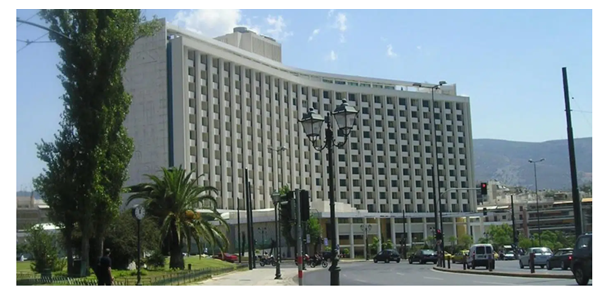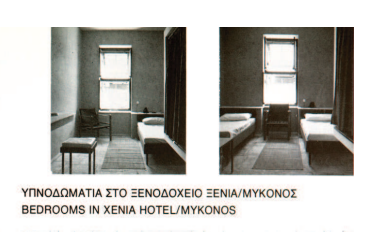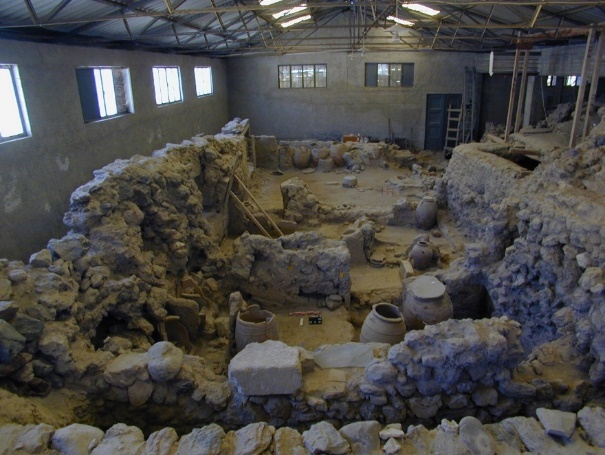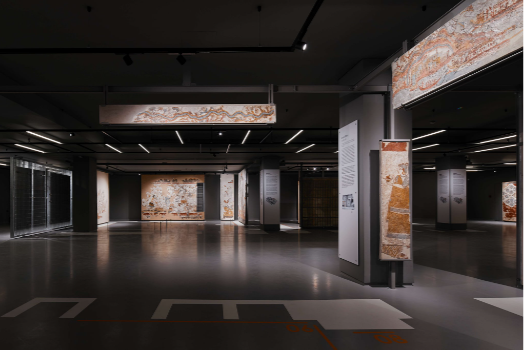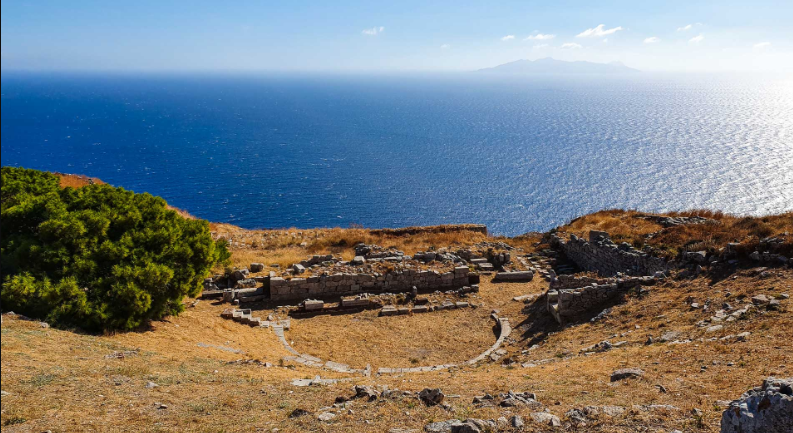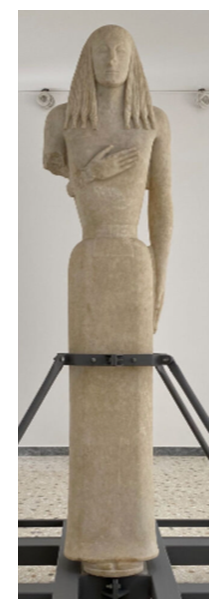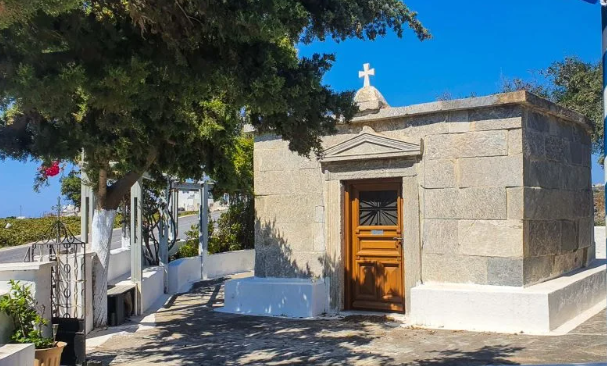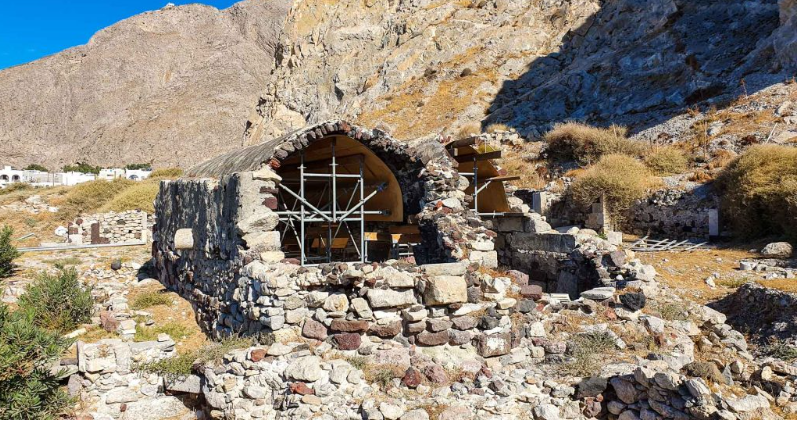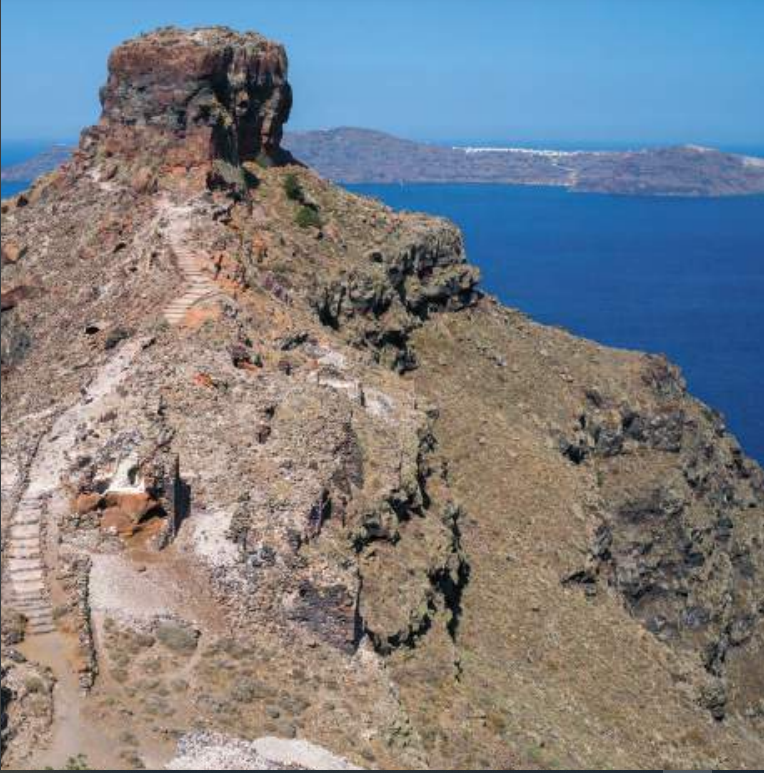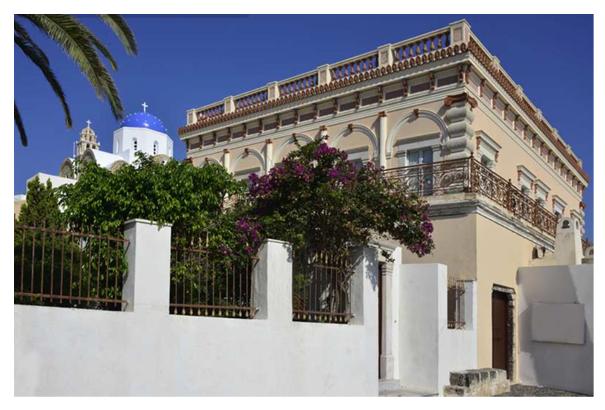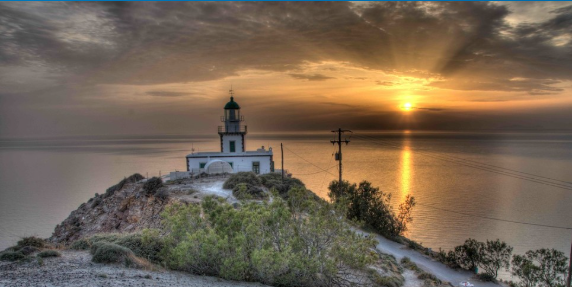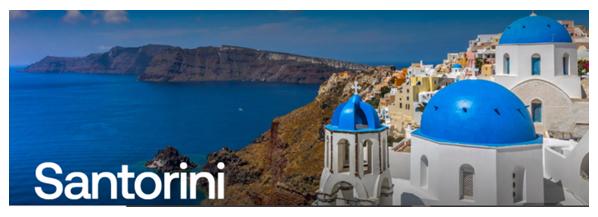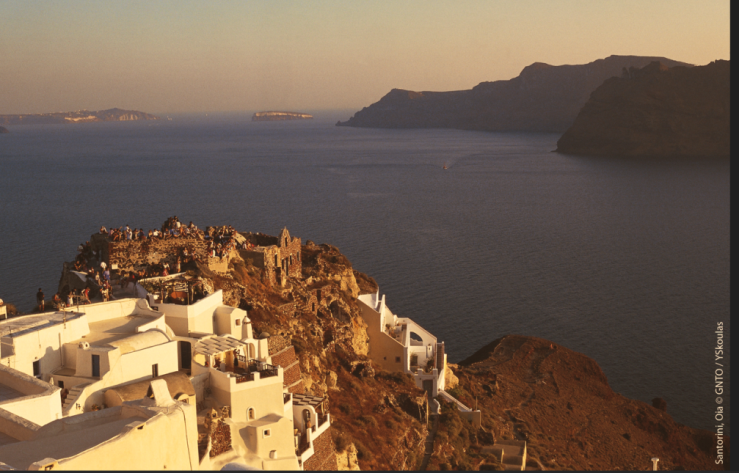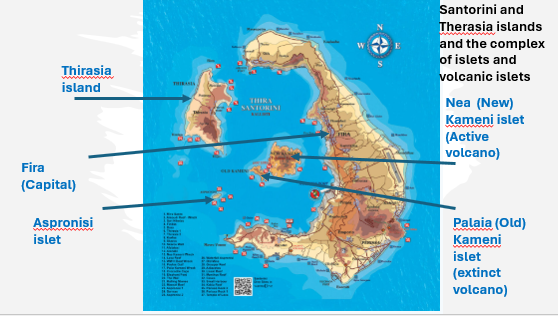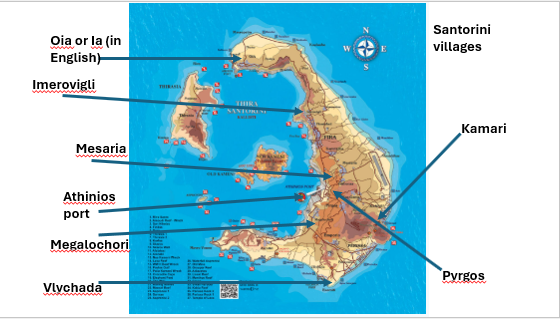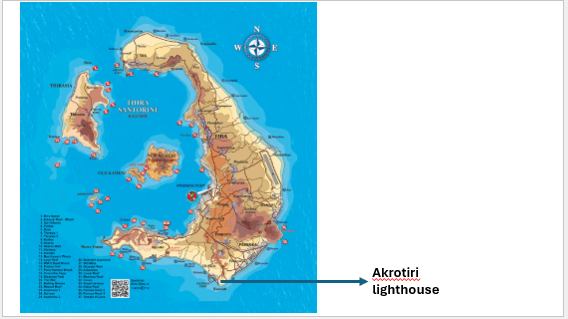-
Paper Information
- Paper Submission
-
Journal Information
- About This Journal
- Editorial Board
- Current Issue
- Archive
- Author Guidelines
- Contact Us
Archaeology
p-ISSN: 2332-838X e-ISSN: 2332-841X
2024; 11(1): 1-14
doi:10.5923/j.archaeology.20241101.01
Received: Nov. 10, 2024; Accepted: Dec. 6, 2024; Published: Dec. 30, 2024

Santorini1 "Genius Loci" and Its Relation to the Over Tourism Phenomenon. Sustainable Cultural Tourism Can be a Solution
Mimika (Dimitra) Krigka
Independent Researcher, Archaeologist, Dr of Prehistoric Archaeology, MA on Arts, Cultural Heritage, Development Policies by the Hellenic Open University, Greece
Correspondence to: Mimika (Dimitra) Krigka, Independent Researcher, Archaeologist, Dr of Prehistoric Archaeology, MA on Arts, Cultural Heritage, Development Policies by the Hellenic Open University, Greece.
| Email: |  |
Copyright © 2024 The Author(s). Published by Scientific & Academic Publishing.
This work is licensed under the Creative Commons Attribution International License (CC BY).
http://creativecommons.org/licenses/by/4.0/

Santorini, one of the most famous holiday destinations in the world, has a history of touristic development and a long and important cultural history, ancient and modern. In this study we search for the beginnings and the causes of the island’s development and history in the ages. We will also try to discover why it has become so world-renowned and how the poor island of 1950 and 1960 became wealthy in the 21st century.
Keywords: Tourism, Cultural tourism, Santorini, Cultural heritage, Tourist gaze, Heterotopia
Cite this paper: Mimika (Dimitra) Krigka, Santorini1 "Genius Loci" and Its Relation to the Over Tourism Phenomenon. Sustainable Cultural Tourism Can be a Solution, Archaeology, Vol. 11 No. 1, 2024, pp. 1-14. doi: 10.5923/j.archaeology.20241101.01.
Article Outline
1. Introduction
- Santorini, or Thera, as its official name is, is a Greek island in the southeastern part of the Aegean Sea, opposite the northern coasts of Crete (see Maps 1 and 2, below at the end of the text). Although a small island, it has a long history and cultural remains. However, most of all, its semi-circular shape has its modern appearance due to its volcanic history that goes back to 180000 years before2.The island of Santorini belongs to the Cyclades complex and is small, with a few thousand permanent inhabitants. Its capital is Fira (see map 5, below at the end of the text), and there are several smaller settlements scattered along the island. The island of Santorini is crescent- shaped and its shape is the outcome of a majestic volcanic eruption that is called the "Minoan." It occurred at the beginning of the Late Bronze Age in Crete and Thera, when the Minoan culture was at its acme. After many theories, the "Minoan" eruption is dated around 1630- 1613 B.C.3.Some consequences of the "Minoan" volcanic eruption were the volcano chamber eruption and the sinking of a significant part of the island into the sea. A large amount of volcanic material, like pumice and tephra, was thrown all over and covered most of the island. The eruption formed a tsunami wave, reaching Crete and the southeastern Aegean Sea.Santorini's ground is volcanic, meaning the cultivations grow on the volcanic ground without water. For that reason, Santorini is known for its wineries.The height of the island's ground and the leveling of the sea are different on the western and eastern sides. On its external eastern side, the leveling to the sea is smooth, and the island opens to the Aegean Sea. In contrast, the steep and high cliffs on its internal side were shaped during the volcanic "Minoan" eruption, making the sea's rocky volcanic borders. This part of the sea under the steep rocky cliffs is much deeper than the rest of the Aegean Sea and has been called "caldera"4 (see Map 2, below at the end of the text), after the Spanish word for the Basin.During the inauguration of the completion of 60 years for the International Union of Geological Sciences (IUGS) a book on the First 100 Geological Heritage sites5 was published in Zumaia (Spain) in 2022. The Santorini volcano has been listed in this 100 World Geological Heritage Monuments6 edition as a recognition of its uniqueness.It has become synonymous with an internationally known holiday place and a globally favorite destination. We will try to discover why it has become so world-renowned and how the poor island of 1950 and 1960 became wealthy in the 21st century.
2. Tourism Phenomenon in Greece
- Tourism in Greece has a long history since there is evidence from antiquity of travelers noting the worth-seeing sites. There is a historical source of the Travels of Pausanias7 and his writings about what he saw along the Greek periphery in the 2nd century A.D. Much later, when the 'Grand Tour"8 of the Europeans added Greece to its itinerary in the 19th century, a slow start to tourism started. The first facilities to house foreign visitors appeared in Greece. After World War II (1940- 1944)9 and the Civil War (1945- 1949)10, Greece managed to start over again. American economic help with the Marshall Plan11 in 1948 played an important role in tourism development. The Americans saw the prospects of the Greek monuments for tourism and encouraged the Greeks to develop tourism.The Greek National Tourism Organization12 was founded in 192913, it was re-established in 195014, and it played the most important role in tourist development. The foundation of the Hilton15 hotel (Fig. 1) in the center of Athens was an emblematic moment, along with the building of the Mont Parnes Hotel16 on the outskirts of Athens, Mount Parnes. Both were made by the architect Emm. Vourekas team17.
3. Economic Profit
- Today, sometime after the economic crisis and the pandemic, tourism in all its forms has become the main occupation and seasonal employment for most Greeks. When they travel, tourists use all the facilities related to tourism and eventually make the money to move. In the part of the culture, the Greek government has now seen the economic profit that the money made each tourist season from the tickets of museums and sites is an essential part of the state's income. Therefore, they are to be given attention and funds to improve their facilities for the public or for the events they organize for the public. In the same sense, Greece is not only a place with antiquities that are worthy of seeing, but there is also the Modern Culture35 and the Intangible Culture36 that can add value and authenticity to the experience of the tourists' visits. Therefore, funding for the festivals and the units that work with traditional agricultural productions and the making of local produce is also to be granted. However, Greece's economy is not stable, and the economic crisis it passed has yet to finish.
4. Santorini Role
- Greece's national Gross Domestic Product has been dramatically strengthened by the tourist income Santorini makes each year during the tourist season. Santorini delayed the touristic development of the rest of the country because of the large and catastrophic earthquake of 1956. The tourists made their appearance in small numbers in the beginning because back then, the only port that the island had was under the Fira town cliff in the caldera. In 1972, the Athinios port (see Map 5, below at the end of the text) in the southcentral part of the island and the caldera started working37 after many unsuccessful plans of the port construction, and in 202238, the port was renovated and widened. Today, this is the island's port, and a new one is under discussion39 since more space is needed for the number of ferries, cruise ships, cars, buses, etc. than the one in the existing Athinios port40. Driving up to the top of the caldera from the port is sometimes dangerous because of the rocks, curves, and narrow roads41. Before the making of Athinios, small boats brought tourists to the Santorini coasts, and going uphill to Fira town was made with mules and donkeys whom the owners rented to transport the tourists with their luggage uphill. Back then, this was the only way. Today, this habit still exists in Fira. However, today, we also think about animal welfare, and this habit is considered brutal by animal protection associations and laws42. Also, today, uphill-downhill communication in Fira is more accessible since a cable car43 does this daily. The Loula and Evangelos Nomikos Foundation donated the cable car to the Theran Municipality in 197844.The hotel development evidence over the years in Santorini was relatively slow initially and increased later. The Hotel Atlantis (Fig. 3) in the center of Fira town with a splendid view to the caldera dates from 195245, and it is the oldest hotel on the island that still functions. Evidence shows that the hotel’s architect was Venetsanos Ioannis, and the building was bought by the GNTO in 196146, with the Royal National Institution being the initial owner.
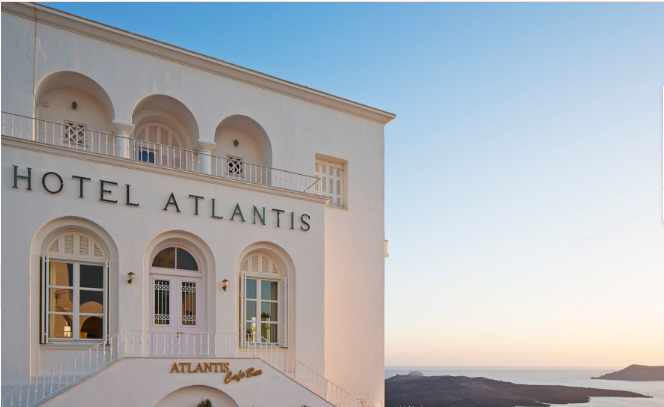 | Figure 3. View of the Hotel Atlantis at Fira, Santorini (Photo source: Hotel Atlantis, Photo Gallery, https://www.atlantishotel.gr/photos, Last accessed 30/11/2024) |
5. Genius Loci and Heterotopia52
- The natural landscape attracts people's eyes, and tourists who visit a place for its natural beauty and attractions also feel attracted. People like to see lovely and emblematic places worldwide and take pictures53 to prove to their family and friends that they made it there. On the other hand, each place has its character, its «genius loci» that differentiates it from every other place in the world. In Santorini's case, the height of the caldera cliffs and the sea's splendid view from above (Fig. 4) are the island's genius loci. In other words, the characteristic makes it unique or answers a tourist's question: "What does Santorini have that you can't find elsewhere on the planet?"
 | Figure 4. View to the caldera from Fira in 1950- 1955 by Voula Papaioannou, a well-known Greek photographer (Photo source: obtained from the Benaki Museum Photographic Archive) |
6. Santorini's Cultural Heritage
- Human habitation is attested in Santorini since the Neolithic times (about 5300 B.C.)59. The late professor Spyridon Marinatos60 revealed the large city of the Early Late Bronze Age (around 1630- 1600 B.C.61), covered under tons of volcanic material, impressively appeared in front of his eyes and the world, untouched by human hands after thousands of years62. The volcano erupted when the coastal city of Akrotiri flourished by holding the sea trade of the whole Mediterranean Sea at the time. The toxic rain and the tsunami caused after the eruption created floods and possibly destroyed crops in Minoan Crete.Today, the archaeological site of Akrotiri (see Map 3, below at the end of the text) lies in the southeastern part of the island of Santorini, quite close to the harbor of the modern town of Akrotiri.This site offers visitors the opportunity to see and experience the way the prehistoric city was functioning in its entirety, as the state of preservation of the buildings remains astonishing (Fig. 6). The ancient two—and three-story buildings stand still where they used to be63, and their interiors are visible to the visitor. The city streets and squares make an unforgettable experience of a city still in use.
 | Figure 12. The Byzantine church of Episkopi (Mesa Gonia, Santorini). (Photo source: Santorini, More.com, https://santorini-more.com/panagia-episkopi-church/?v=9b7d173b068d, Last accessed 30/11/2024) |
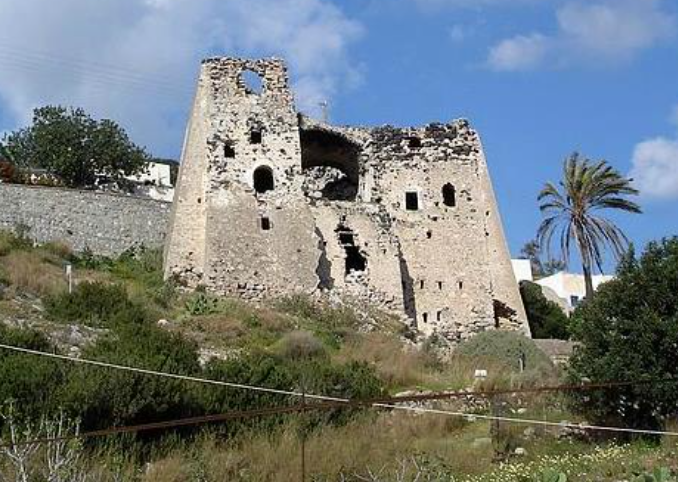 | Figure 14. The Venetian tower of the village of Emporeion (Santorini) (Photo source: Goulas of Emporio, Kastrologos- Castles of Greece, https://tinyurl.com/27geq3xz, Last accessed 28/9/2024. |
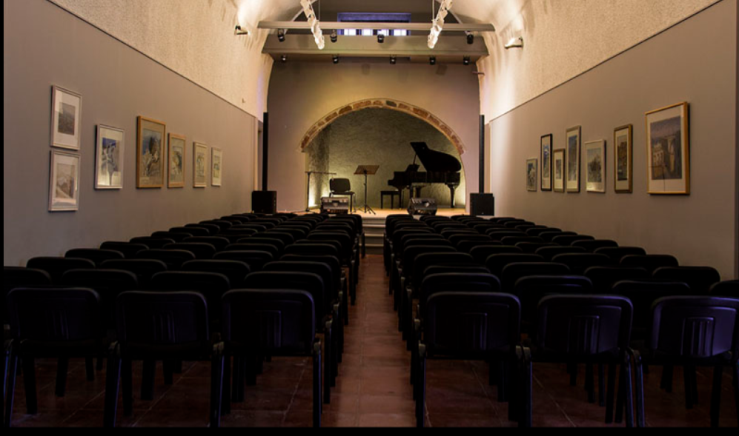 | Figure 18. Gyzi Megaron, the musical festivities hall (Photo source: Gyzi Megaron, Photo gallery, https://gyzimegaron.gr/en/home/, Last accessed 24/9/2024 |
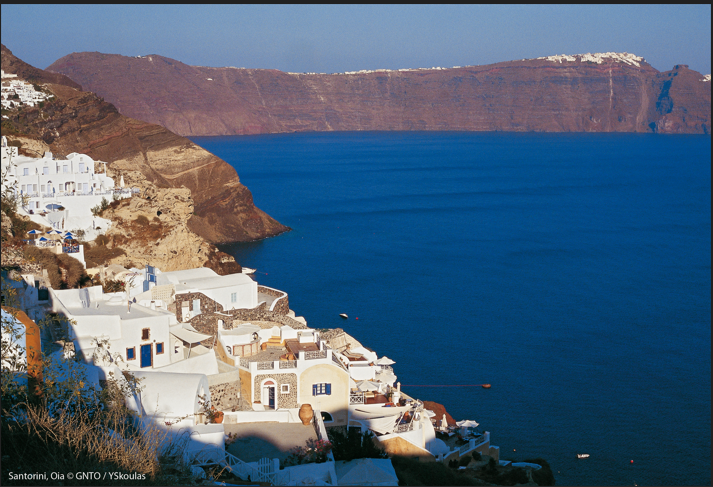 | Figure 19. View of the village of Ia. Building in terraces (Photo source: NGTO photographical open access web archive, Photographer: Yiannis Skoulas) |
7. Conclusions
- The number of options regarding monuments, museums, and cultural events that can be visited and experienced in Santorini has been shown in the analysis, and these can work in parallel with the fantastic caldera view and the sunset "clapping" in Ia (Fig. 21, 22).
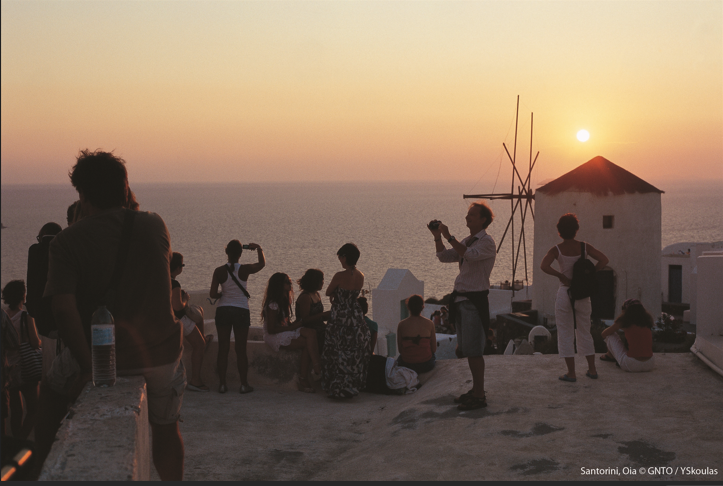 | Figure 22. Tourists enjoying the Ia sunset (Photo source: NGTO photographical open access web archive, Photographer: Yiannis Skoulas) |
MAPS
 | Map 1. Map of Greece. Santorini is in the Aegean Sea, right above Crete (Map Source: Santorini Travel, Santorini map, https://www.santorinitravel.com/santorini-map/, Last accessed on 26/11/2024) |
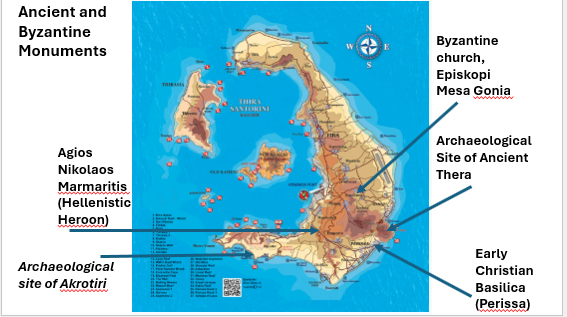 | Map 3. Ancient and Byzantine period monuments in Santorini (Map Source: Santorini Travel, Santorini map, https://www.santorinitravel.com/santorini-map/, Last accessed on 30/11/2024) |
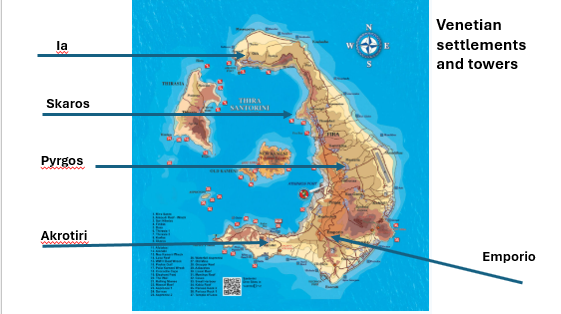 | Map 4. Sites with remnants (towers and settlements) of Venetian occupation (Map Source: Santorini Travel, Santorini map, https://www.santorinitravel.com/santorini-map/, Last accessed on 30/11/2024) |
Notes
- 1. The island's official name is Thera, but everybody knows the name Santorini, and this is the term that will be used here.2. Smithsonian Institute, National Museum of Natural History, Global Volcanism Program, Santorini, Geological Summary, https://volcano.si.edu/volcano.cfm?vn=212040, (Last accessed 22/9/2024.)3. Friedrich, W. 2013, 37. (The Minoan Eruption of Santorini around 1613 B.C. and its Consequences, in Tagungen des Landesmuseums fur Vorgeschichte Halle, Band 9, 37- 48, https://tinyurl.com/26dq2tkk (Last accessed 22/9/2024).4. For the translation of the word caldera, from Spanish to English, see Cambridge Dictionary, https://dictionary.cambridge.org/dictionary/spanish-english/caldera, (Last accessed 2/9/2024).5. Hilario, A., Asrat, A., Van Wyk de Vries, B., Mogk, D., Lozono, G., Zhang, J., Brilaha, J., Vegas, J., Lemon, C., Corcovilla, L., Finney, S. (eds.), The First 100 IUGS 6oth Anniversary, IUGS, Zumaia, 2021. 6. Prete, G. 2022. Two Greek Regions among the top 100 World Geological Heritage Monuments, Greek Reporter, October 6th, https://tinyurl.com/2a96gowj, Last accessed 22/9/2024. https://iugs-geoheritage.org/.7. Pausanias. Description of Greece, Volume I: Books 1-2. Translated by W. H. S. Jones. Loeb Classical Library 93. Cambridge, MA: Harvard University Press, 1918, https://tinyurl.com/2ysehdbx, Last accessed 20/9/2024).8. What was the Grand Tour? Royal Museums Greenwich, https://www.rmg.co.uk/stories/topics/what-was-grand-tour, Last accessed 20/9/2024.9. Hughes, T.A. and Royde- Smith, J.G., World War II, 1939- 1945, in Britannica, https://www.britannica.com/event/World-War-II, Last accessed 21/9/2024.10. The Editors of Encyclopedia Britannica, Greek Civil War, Greek History, in Britannica, https://www.britannica.com/event/Greek-Civil-War, Last accessed 22/9/2024.11. The Editors of Encyclopaedia Britannica, Marshall Plan Summary, in Britannica, https://www.britannica.com/summary/Marshall-Plan, Last accessed 22/9/2024.12. The Greek National Tourist Organization will be abbreviated as GNTO here.13. Ελληνικός Οργανισμός Τουρισμού, Greece, Ποιοι Είμαστε, https://gnto.gov.gr/organismos/poioi-eimaste/, Last accessed 21/9/2024.14. Ελληνικός Οργανισμός Τουρισμού, Greece, Ποιοι Είμαστε, https://gnto.gov.gr/organismos/poioi-eimaste/, Last accessed 21/9/2024.15. Filippides 2015, 88. (Filippides, D., Architecture in the Era of Mass Tourism, 88- 97, in Aesopos, Y. (editor), Tourism Landscapes, Remaking Greece, Domes Editions, Athens 2015).16. Filippides 2015, 89.17. Filippides 2015, 88.18. Filippides 2015, 88.19. Aesopos 2015, 109. Tourism Landscapes: Remaking Greece, in Aesopos, Y. (editor), Tourism Landscapes, Remaking Greece, Domes Editions, Athens 2015, 108- 123).20. Filippides 2015, 90.21. In Greek the word «Ξένος» means the foreigner. Therefore, the word Ξενία (Xenia) is the half part of the word Φιλοξενία, which means Hosting the guests, the foreigners. 22. Aesopos 2015, 114. Tourism Landscapes: Remaking Greece, in Aesopos, Y. (editor), Tourism Landscapes, Remaking Greece, Domes Editions, Athens 2015, 108- 123).23. Konstantinides Aris (1913- 1993), Benaki Museum, https://tinyurl.com/27j5m5py, Last accessed 22/9/2024.24. Aesopos 2015, 116. Tourism Landscapes: Remaking Greece, in Aesopos, Y. (editor), Tourism Landscapes, Remaking Greece, Domes Editions, Athens 2015, 108- 123).25. Wrapped in History, Patmos Aktis, Resort and Spa, Greece, https://www.patmosaktis.gr/wrapped-in-history/, Last accessed 21/9/2024).26. Filippides 2015, 90- 1.27. Paraskevopoulou, P., Exploring the Hippie Caves at Matala, Crete, GREEK CITY TIMES, https://tinyurl.com/2yfzwk4q, Last accessed 28/9/2024. 28. Filippides 2015, 91- 2.29. Filippides 2015, 96.30. Aesopos 2015, 120.31. Theater of Epidaurus, Diazoma, https://diazoma.gr/en/theaters/theatre-of-epidavrus/, Last accessed 23/9/2024.32. Theater of Epidaurus, Diazoma, https://diazoma.gr/en/theaters/theatre-of-epidavrus/, Last accessed 23/9/2024. For the Athens- Epidaurus festival, see Athens, Epidaurus Festival, https://aefestival.gr/, Last accessed 23/9/2024.33. For the Athens- Epidaurus festival, see Athens, Epidaurus Festival, https://aefestival.gr/, Last accessed 23/9/2024.34. Greece, UNESCO World Heritage Convention, https://whc.unesco.org/en/statesparties/gr, Last accessed 23/9/2024.35. Modern Culture, Ministry of Culture, Hellenic Republic, https://tinyurl.com/25tt66y8, Last accessed 23/9/2024.36. Intangible Cultural Heritage of Greece, https://ayla.culture.gr/en/, Last accessed 23/9/2024.37. The History, Boatmen Union of Santorini, http://www.boatmenunionsantorini.com/the-history/, Last Accessed 23/9/2024.38. Unknown, Λιμάνι Αθηνιού: Ένας Χρόνος μετά, Atlantea, 6/2/2021, https://atlantea.news/limani_athiniou_enas_xronos_meta/, Last Accessed 23/9/2024.39. Νέο Λιμάνι στην Σαντορίνη ως ύψιστη εθνική προτεραιότητα, Neasantorinis, 31/7/2024, https://tinyurl.com/2xnmba2g, Last accessed 23/9.2024.40. Bulletin Editor, Santorini Sets to ban Cruise Tourists Next year, cruise.co.uk, The Real Cruise People, https://tinyurl.com/2c2vrg2q, Last Accessed 23/9/2024.41. Bulletin Editor, Santorini Sets to ban Cruise Tourists Next year, cruise.co.uk, The Real Cruise People, https://tinyurl.com/2c2vrg2q, Last Accessed 23/9/2024.42. Should you do a Santorini Donkey Ride? Greece Travel Secrets, https://tinyurl.com/25ppt7st, Last accessed 23/9/2024.43. Santorini Cable Car, https://www.scc.gr/cablecar.htm, Last accessed 23/9/2024.44. Santorini Cable Car, https://www.scc.gr/cablecar.htm, Last accessed 23/9/2024.45. Hotel Atlantis, Our History, www.atlantishotel.gr/our-history, Last accessed 23/9/2024.46. Μουσά Μ., 2010, 257. (Πρόγραμμα Ξενία: Ονομασία, μελέτες και κατασκευές, τυπολογία και κατάλογοι έργων, στο Μεταπολεμικός Μοντερνισμός- Αρχιτεκτονική, Πολιτική και Τουρισμός στην Ελλάδα, 1950- 1965, Εθνικό Μετσόβιο Πολυτεχνείο- Σχολή Αρχιτεκτόνων Μηχανικών, Πρόγραμμα Ενίσχυσης Βασικής Έρευνας, ΠΕΒΕ 2010, Αθήνα 2012, 223- 276).47. Majestic Hospitality, The Majestic Hotel- Santorini. https://www.hotel-majestic.gr/el/giortazoume-50-hronia/, Last accessed 23/9/2024.48. Philippides, D. (ed.) 2003, 143.49. The Greek name of the town is Oia. In English this is read as Ia.50. Puckett, J., 2024, These Greek islands are implementing New Fees for cruise ship visitors, Conde Nast Traveler, 11/9/2024, https://tinyurl.com/2dohlkev, Last accessed 9/12/2024.51. Filippidis 2015, 98- 101.52. Foucault, M., 1984, 3. Of other Spaces: Utopias and Heterotopias, Architecture/Mouvement/Continuite, October 1984 (“Des Espaces Autres”, March 1967, Translated from the French by Jay Miskowiec), 1- 9, https://web.mit.edu/allanmc/www/foucault1.pdf, Last accessed 23/9/2024.53. Levine, I., Psychology of Travel: Does taking photos enhance Enjoyment? Travel Tips, more time to travel- Explore new places and savor new tastes, March 5, 2024, https://tinyurl.com/2a3tux93, Last Accessed 23/9/2024.54. Montagne Saint Victoire, Paul Cezanne (1839- 1906), Musee d’ Orsay, https://tinyurl.com/2c8srsnm, Last Accessed 23/9/202455. “Wanderer above the Sea of Fog” on travel, Caspar David Friedrich, Hamburger- Kunsthalle, https://tinyurl.com/258lw4xe, Last accessed 23/9/2024.56. Martin, G.R. 2017, Birds’ eye views- a question of reality, OUPblog, Oxford University Press’s, Academic Insights for the thinking world, March 27, https://blog.oup.com/2017/03/birds-eye-views-question-reality/, Last accessed 23/9/2024.57. Foucault, M., 1984, 3. Of other Spaces: Utopias and Heterotopias, Architecture/Mouvement/Continuite, October 1984 (“Des Espaces Autres”, March 1967, Translated from the French by Jay Miskowiec), 1- 9, https://web.mit.edu/allanmc/www/foucault1.pdf, Last accessed 23/9/2024.58. Caletrio, J. “The Tourist Gaze by John Urry”, 25 March 2019, https://tinyurl.com/2damzxrq, Last accessed 25/9/2024.59. Doumas, Ch., 2016, 22. (Doumas, Ch., Prehistoric Thera, J.S. Latsis Public Benefit Foundation, Athens 2016). 60. Doumas, Ch., 2016, 18. (Doumas, Ch., Prehistoric Thera, J.S. Latsis Public Benefit Foundation, Athens 2016). 61. Doumas, Ch., 2016, 21. (Doumas, Ch., Prehistoric Thera, J.S. Latsis Public Benefit Foundation, Athens 2016). 62. Doumas, Ch., 2016, 28. (Doumas, Ch., Prehistoric Thera, J.S. Latsis Public Benefit Foundation, Athens 2016). 63. Doumas, Ch., 2016, 30- 58. (Doumas, Ch., Prehistoric Thera, J.S. Latsis Public Benefit Foundation, Athens 2016). 64. Doumas, Ch., 2016, 20. (Doumas, Ch., Prehistoric Thera, J.S. Latsis Public Benefit Foundation, Athens 2016). 65. Prehistoric Thera Museum, Greek Ministry of Culture, ΟΔΥΣΣΕΥΣ, http://odysseus.culture.gr/h/1/eh151.jsp?obj_id=3325, Last accessed 24/9/2024. 66. Collection of Antiquities of Thera, National Archaeological Museum, https://www.namuseum.gr/en/collection/syllogi-archaiotiton-thiras/, Last accessed 28/9/2024.67. Ancient Thera, Description, Greek Ministry of Culture, ΟΔΥΣΣΕΥΣ, http://odysseus.culture.gr/h/3/eh352.jsp?obj_id=2454, Last accessed 24/9/2024.68. Ancient Thera, Description, Greek Ministry of Culture, ΟΔΥΣΣΕΥΣ, http://odysseus.culture.gr/h/3/eh352.jsp?obj_id=2454, Last accessed 24/9/2024.69. Ancient Thera, Description, Greek Ministry of Culture, ΟΔΥΣΣΕΥΣ, http://odysseus.culture.gr/h/3/eh352.jsp?obj_id=2454, Last accessed 24/9/2024.70. Ancient Thera, Description, Greek Ministry of Culture, ΟΔΥΣΣΕΥΣ, http://odysseus.culture.gr/h/3/eh352.jsp?obj_id=2454, Last accessed 24/9/2024.71. Ancient Thera, Description, Greek Ministry of Culture, ΟΔΥΣΣΕΥΣ, http://odysseus.culture.gr/h/3/eh352.jsp?obj_id=2454, Last accessed 24/9/2024.72. Ancient Thera, Description, Greek Ministry of Culture, ΟΔΥΣΣΕΥΣ, http://odysseus.culture.gr/h/3/eh352.jsp?obj_id=2454, Last accessed 24/9/2024.73. Ancient Thera, Description, Greek Ministry of Culture, ΟΔΥΣΣΕΥΣ, http://odysseus.culture.gr/h/3/eh352.jsp?obj_id=2454, Last accessed 24/9/2024.74. Ancient Thera, Description, Greek Ministry of Culture, ΟΔΥΣΣΕΥΣ, http://odysseus.culture.gr/h/3/eh352.jsp?obj_id=2454, Last accessed 24/9/2024.75. Ancient Thera, Description, Greek Ministry of Culture, ΟΔΥΣΣΕΥΣ, http://odysseus.culture.gr/h/3/eh352.jsp?obj_id=2454, Last accessed 24/9/2024.76. Ancient Thera, Description, Greek Ministry of Culture, ΟΔΥΣΣΕΥΣ, http://odysseus.culture.gr/h/3/eh352.jsp?obj_id=2454, Last accessed 24/9/2024.77. Ancient Thera, Description, Greek Ministry of Culture, ΟΔΥΣΣΕΥΣ, http://odysseus.culture.gr/h/3/eh352.jsp?obj_id=2454, Last accessed 24/9/2024.78. The Editors of Encyclopedia Britannica, Carneia, Ancient Greek festival, Britannica, https://www.britannica.com/topic/Carneia, Last accessed 24/9/2024.79. Ancient Thera, Description, Greek Ministry of Culture, ΟΔΥΣΣΕΥΣ, http://odysseus.culture.gr/h/3/eh352.jsp?obj_id=2454, Last accessed 24/9/2024.80. Archaeological Museum of Thera, History, Greek Ministry of Culture, ΟΔΥΣΣΕΥΣ, http://odysseus.culture.gr/h/1/eh152.jsp?obj_id=3400, Last accessed 24/9/2024.81. Kokkinidis, T. 2022. “The Kore of Thera: Ancient Greek Masterpiece Brought out of Storage, GREEK REPORTER, September 2, 2022, https://tinyurl.com/2atomc2h, Last accessed 24/9/2024.82. Unknown, An Ancient temple near Emporio Village, Santorini Discovery Tours, https://tinyurl.com/23efqonb, Last accessed 24/9/2024.83. Perissa site (Thera) Perissa- Περίσσα, Perissa, Archaic Site in Thera Cyclades, TOPOSTEXT, Aikaterini Laskaridis Foundation, https://topostext.org/place/364255XPer, Last accessed 25/9/2024.84. Athanasoulis, D. and Efstathiou, M. and Sakellakou Ch. and Vogkli M. & Kourousia, M. 2021, Santorini- Thera, 30, in Mo.Na: Monuments in Nature: A Creative Co- Existence, European Centre for Byzantine and Post Byzantine Monuments, Karagianni F. and Tarvou, S. (eds.), Project Co- Funded by the European Union and National Funds of the participating countries, Thessaloniki 2021, http://www.interreg-balkanmed.eu/gallery/Files/A-Creative-Co-existence.pdf, Last accessed 24/9/2024.85. Athanasoulis, D. and Efstathiou, M. and Sakellakou Ch. and Vogkli M. & Kourousia, M. 2021, Santorini- Thera, 30, in Mo.Na: Monuments in Nature: A Creative Co- Existence, European Centre for Byzantine and Post Byzantine Monuments, Karagianni F. and Tarvou, S. (eds.), Project Co- Funded by the European Union and National Funds of the participating countries, Thessaloniki 2021, http://www.interreg-balkanmed.eu/gallery/Files/A-Creative-Co-existence.pdf, Last accessed 24/9/2024.86. Mitsani, A., Church of Episkopi at Mesa Gonia, Thera, Greek Ministry of Culture, ΟΔΥΣΣΕΥΣ, http://odysseus.culture.gr/h/2/eh251.jsp?obj_id=1696, Last accessed 24/9/2024.87. Athanasoulis, D. and Efstathiou, M. and Sakellakou Ch. and Vogkli M. & Kourousia, M. 2021, Santorini- Thera, 30, in Mo.Na: Monuments in Nature: A Creative Co- Existence, European Centre for Byzantine and Post Byzantine Monuments, Karagianni F. and Tarvou, S. (eds.), Project Co- Funded by the European Union and National Funds of the participating countries, Thessaloniki 2021, http://www.interreg-balkanmed.eu/gallery/Files/A-Creative-Co-existence.pdf, Last accessed 24/9/2024.88. Athanasoulis, D. and Efstathiou, M. and Sakellakou Ch. and Vogkli M. & Kourousia, M. 2021, Description of the Work Done, 36, in Mo.Na: Monuments in Nature: A Creative Co- Existence, European Centre for Byzantine and Post Byzantine Monuments, Karagianni F. and Tarvou, S. (eds.), Project Co- Funded by the European Union and National Funds of the participating countries, Thessaloniki 2021, 33- 45, http://www.interreg-balkanmed.eu/gallery/Files/A-Creative-Co-existence.pdf, Last accessed 24/9/2024.89. Athanasoulis, D. and Efstathiou, M. and Sakellakou Ch. and Vogkli M. & Kourousia, M. 2021, Description of the Work Done, 33, in Mo.Na: Monuments in Nature: A Creative Co- Existence, European Centre for Byzantine and Post Byzantine Monuments, Karagianni F. and Tarvou, S. (eds.), Project Co- Funded by the European Union and National Funds of the participating countries, Thessaloniki 2021, 33- 45, http://www.interreg-balkanmed.eu/gallery/Files/A-Creative-Co-existence.pdf, Last accessed 24/9/2024.90. Athanasoulis, D. and Efstathiou, M. and Sakellakou Ch. and Vogkli M. & Kourousia, M. 2021, Description of the Work Done, in Mo.Na: Monuments in Nature: A Creative Co- Existence, European Centre for Byzantine and Post Byzantine Monuments, Karagianni F. and Tarvou, S. (eds.), Project Co- Funded by the European Union and National Funds of the participating countries, Thessaloniki 2021, 33- 45, http://www.interreg-balkanmed.eu/gallery/Files/A-Creative-Co-existence.pdf, Last accessed 24/9/2024.91. Maritime Museum of Oia, Santorini- Municipality Travel Guide, https://www.santorini.gr/santorini/culture/museums/maritime-museum-of-oia/, Last accessed 24/9/2024.92. Argyros Mansion, Santorini, https://argyrosmansion.com/en/, Last accessed 24/9/2024.93. Walking Tourism- Promoting Regional Development, 31 January 2019, UN Tourism, https://www.unwto.org/global/publication/walking-tourism-promoting-regional-development, Last accessed 24/9/2024.94. Walking Tourism- Promoting Regional Development, 31 January 2019, UN Tourism, https://www.unwto.org/global/publication/walking-tourism-promoting-regional-development, Last accessed 24/9/2024.95. Information about the lighthouse are in the Hellenic Navy Lighthouse Service website, https://yf.hellenicnavy.gr/diamoni-prosopikou-tou-pn-se-farous/faros-akrotiri-santorini/, Last Accessed 9/12/2024. The Santorini Lighthouse is protected as a Monument by the Greek Ministry of Culture. 96. Liatsou, M., 2024, Explore the Akrotiri Lighthouse in Santorini on World Lighthouse Day- August 18nth, Santorini.net, My Santorini Network, 9/8/2024, https://www.santorini.net/explore-the-akrotiri-lighthouse-in-santorini-on-world-lighthouse-day-august-18th/97. Tomato Industrial Museum D. Nomikos, The Museum, https://www.tomatomuseum.gr/the-museum/, Last accessed 24/9/2024.98. Cine Kamari, Santorini, https://santorinicinema.com/, Last accessed 24/9/2024.99. History of Open-Air cinemas in Greece, Cine Kamari, Santorini, https://santorinicinema.com/about.php, Last Accessed 24/9/2024.100. Gyzi Megaron, Where Culture meets History, https://gyzimegaron.gr/en/home/, Last accessed 24/9/2024.101. Estia (Association) Pyrgou Kallistis, https://www.santorinipyrgos.com/the-association, Last accessed 24/9/2024.102. Preservation and Development of Traditional Settlements (1975- 1992), GNTO Programme, Athens 1991, https://gnto.gov.gr/entypa/preservation-development-of-traditional-settlements-1975-1992-the-g-n-t-o-programme/, Last accessed 29/11/24.103. Kalafatis, I., 2024. Why Greek Island Houses are blue and white, GREEK REPORTER, June 4, https://tinyurl.com/226o9s8v, Last accessed 30/11/2024.104. The vine culture and wine making heritage in Santorini (Thera, Thirasia), 2018, Intangible Cultural Heritage of Greece, https://ayla.culture.gr/en/i_ampelooiniki_klironomia_tis_santorinis/, Last accessed 24/9/2024.
 Abstract
Abstract Reference
Reference Full-Text PDF
Full-Text PDF Full-text HTML
Full-text HTML